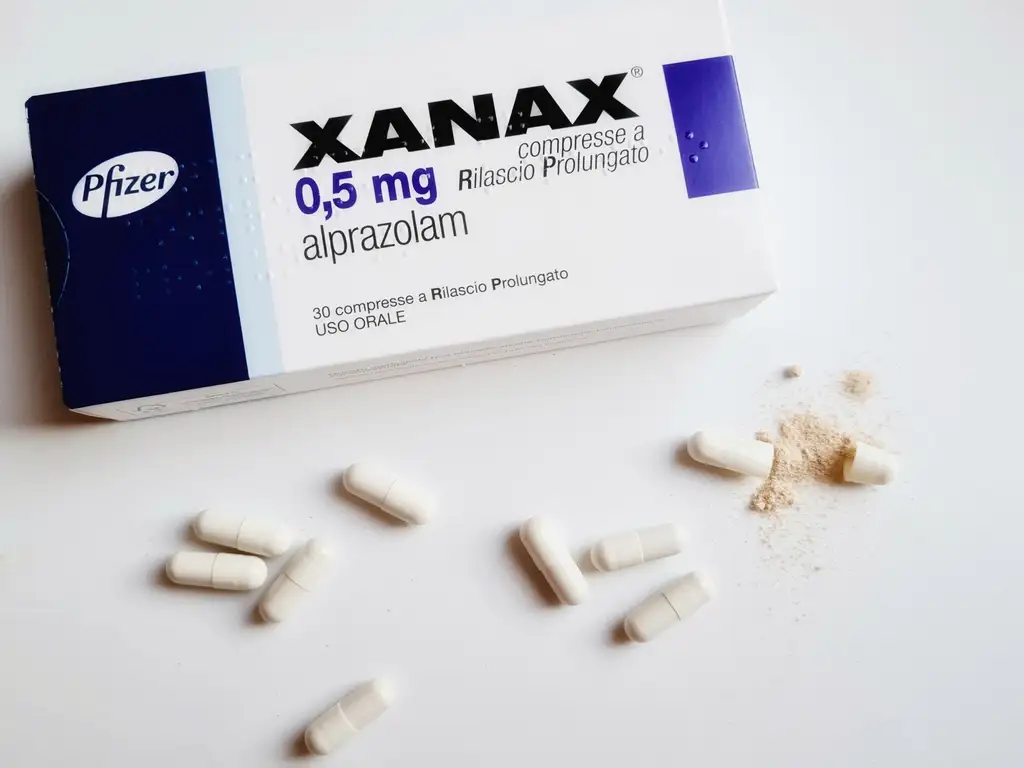Alprazolam is most widely known by the brand name Xanax. Prescription drugs such as Xanax in are a class of substances called benzodiazepines., which are considered to be a controlled substance, and are only available legally through prescription by a psychiatrist or physician.
Benzodiazepines are used to treat anxiety disorders, or anxiety that is combined with depression. Xanax is also used to treat panic disorders and seizures.
Benzodiazepines are considered to be highly addictive. Taking Xanax every day over time will result in drug abuse and a psychological dependency, which in turn becomes a physical dependency, as well. Xanax addiction occurs when it is used every day, on a long term basis. It is considered abuse when the drug is not taken as prescribed, or when it is used by someone to whom it has not been prescribed.
Xanax Abuse
Prescriptions for benzodiazepines spiked between the mid-1990’s and 2015. Since then, drug abuse in the form of benzodiazepine abuse and Xanax addiction has been a growing problem. According to recent data, benzodiazepines such as Xanax, have caused overdose and unfortunately been involved in a significant amount of reported overdose deaths.
After the mid 1990’s, benzodiazepines replaced the older barbiturate type sedatives. Benzodiazepines are generally prescribed for insomnia, anxiety and seizure disorder, but both benzodiazepines and barbiturates are highly addictive. The explosion in prescriptions for Alprazolam and other benzodiazepines have largely been driven by a strong demand from patients seeking relief from anxiety and depression.
Treat Anxiety Disorders
Benzodiazepines are currently preferred over older barbiturate drugs because they have what is known as “a wider therapeutic index”. This means the drug is considered to be safer than barbiturates, if taken as prescribed. “Therapeutic index” is the dose of medication that is effective, without causing an “undesirable outcome”, if used short term.
There are other non-benzodiazepine hypnotics like Ambien which are also preferred over barbiturates for most of these clinical uses and for the same reasons. These newer non-benzodiazepine drugs also have a wider therapeutic index, and physical tolerance develops more slowly.
Xanax Addiction
There are two problems with usage of any drug to deal with anxiety, depression or insomnia. The first is that physical dependence can develop. Our bodies naturally produce chemicals that we need to function. If we abuse Xanax or use any substance, even medication for chapped lips for example, our bodies stop producing the natural substance to relieve chapped lips that we are replacing with the medication.
The second is that Xanax addiction involves development of a psychological dependence, resulting from long term use. Because the body begins to develop a tolerance to the drug, more must be consumed to achieve the same effect. Additionally, Xanax addiction is doubly serious because it is very hazardous to stop taking the drug abruptly, also known as cold turkey. People who use Xanax or other benzodiazepines can experience withdrawal.
Effects of Xanax Addiction
Benzodiazepines slow activity in the central nervous system (CNS), which consists of the brain and spinal cord. For this reason, benzodiazepines are in a class of drugs known as depressants. Xanax use causes a reduction in heart rate, lowers blood pressure and respiration. Because they act on the CNS in this way, Xanax use can cause life threatening consequences, if abused, such as Xanax withdrawal.
The central nervous system has three functions. To take in sensory information, to process that information, and to send out motor signals to all areas of the body, which includes breathing and heart rate. This third function can be severely disrupted when people abuse Xanax.
Signs of Xanax Addiction
Xanax addiction, especially if combined with other drugs like alcohol or opiates, can be extremely dangerous. Xanax affects the CNS by slowing activity, which can affect judgement. Therefore the information taken in by our senses is processed at a much slower rate.
Additionally, benzodiazepine abuse can cause paranoid or suicidal ideation, impair memory, and coordination. Combining alcohol, Xanax and other drugs, can slow breathing and in extreme cases, possibly even lead to death by overdose.
Diagnostic and Statistical Manual – The DSM-5
Authored by the American Psychiatric Association, The Diagnostic and Statistical Manual of Mental Disorders (DSM) is the handbook used by health care professionals in the United States and much of the world as the authoritative guide to the diagnosis of mental health problems. The DSM-5 contains descriptions, symptoms and other criteria for diagnosing mental disorders, like substance use disorder.
The DSM-5 formally categorizes abuse and or addiction to Xanax as a sedative, hypnotic, or anxiolytic (anxiety) use disorder. Anxiolytic drugs are substances which provide a calming or sleep-inducing effect. Benzodiazepines are most usually prescribed to treat anxiety disorder, or panic disorder.
Withdrawal Symptoms from Xanax Abuse
Withdrawal symptoms from abusing Xanax can range from mild – irritability, insomnia, anxiety – to more serious complications such as tachycardia, which is a higher than normal heart rate.
Other symptoms can include abdominal cramps anxiety and muscle tension which can cause feeling a tightness in the chest, sweating, trembling or shaking. Many of these physical, mental and emotional withdrawal symptoms are common for alcohol, and other sedative drugs as well as Xanax.
Xanax Abuse and Xanax Addiction: What’s the Difference?
There is, of course, a difference between occasionally using a drug and suffering from an actual addiction. Having a physical, mental and emotional dependence on a substance can be defined as addiction. Taking a substance as directed by a physician is very different from abuse, drug use and addiction to that substance.
Prescribed use of Xanax is intended to provide a temporary relief from insomnia, anxiety and/or phobia. The intention by patient and physician should involve a plan to deal with the underlying issues that may be causing the anxiety, through some form of treatment such as involvement in 12 step recovery or 1:1 therapy, for example.
Signs of Xanax Abuse and Xanax Addiction
Xanax abuse occurs when an individual uses it without a prescription. Addiction occurs when a physical tolerance builds and more and more must be consumed. Withdrawal symptoms for those who abuse xanax can be mild. However, even if you have been taking Xanax as prescribed for a prolonged period, you can experience severe withdrawal symptoms when the drug is stopped. To ease withdrawal symptoms can require medical detox.
When people abuse Xanax over time, their body and brain develop a dependency on the drug, meaning that when they reduce their use or stop using altogether, they can experience painful, sometimes serious withdrawal symptoms. The desire to avoid uncomfortable benzodiazepine withdrawal symptoms may lead some people to keep abusing Xanax.
Physical Symptoms
Benzodiazepines affect the production of the brain chemical GABA, which is a neurotransmitter that regulates breathing and reasoning, among other things. Because of this fact, the risk of overdose is only increased with the addition someone tends to abuse alcohol or other substances while abusing Xanax.
Alcohol and opiates are also depressant drugs, and should be avoided when individuals are taking Xanax. To mix Xanax creates a combination of two depressants that inhibit reasoning and judgement and can be very hazardous. You can easily see why.
Individuals that abuse benzodiazepines will generally need some medication in order to detox. Also, if other drugs are mixed with Xanax, this can also negatively impact production of this vital neurotransmitter. Insufficient levels of GABA in the brain contribute to anxiety, chronic pain, mood swings, interpersonal or social problems and occasionally epilepsy.
Withdrawal Process
Stopping Xanax after prolonged use requires the assistance and supervision of a physician or other medical professional. The treatment process involves a gradual reduction in the dose, under medical supervision.
However, in order for a person to stay stopped and develop the skills needed to deal with the underlying issues that made it necessary to take Xanax in the first place, it may be necessary to undergo some type of behavioral therapy in a treatment center, or other supportive type environment.
There are a variety of reasons Xanax abuse can turn into an addiction – first, tolerance builds, which means more of the drug must be taken to achieve the same result. Also, if the individual was taking the drug to treat anxiety, the condition will return once the drug is stopped.
Treatment For Xanax Addiction
Because Xanax is very much like alcohol in pill form, individuals suffering from a substance abuse disorder of this type generally require a safe and nurturing environment, in order to begin recovery.
For Xanax addiction treatment to be successful, intervention by trained medical professionals and mental health clinician in a safe environment is required. It also takes work on the part of the addict to recover. There is an underlying reason the addiction occurred in the first place, which needs to be discovered before any real recovery can begin.
Recovery from any addiction is a lifetime process, because unfortunately the saying, “once an addict, always an addict!” is all too true.
Turning Point of Tampa Treatment Programs Addresses Xanax Addiction
Turning Point of Tampa understands Xanax effects and the risk taking behaviors that accompany long term abuse. Our Treatment Center is located on one campus and offers a full continuum of care with Residential Treatment, Day Treatment, Intensive Outpatient Treatment and Inpatient Medical Detox for alcohol and drug addiction; as well as treatment for eating disorders and dual diagnosis.
The Medical Team Turning Point
Hardeep Singh, MD, FASAM, Medical Director – Dr. Hardeep Singh received his medical degree from King George’s Medical College and has been in practice for more than 20 years. Dr. Singh was named Top Doctor by Tampa Magazine in 2023, which was the fifth time he received that honor.
Dr Singh is a member of The American Society of Addiction Medicine. Founded in 1954, ASAM is a professional medical society representing over 6,000 physicians, clinicians and associated professionals in the field of addiction medicine.
Every admission at Turning Point of Tampa goes through a nursing assessment which is reviewed by the medical director to learn about the clients’ substance abuse history as well as any medical needs in order to establish appropriate level of treatment services for the clients success in recovery.
Turning Point of Tampa’s goal is to always provide a safe environment and a solid foundation in 12-Step recovery, in tandem with quality individual therapy and group therapy. We have been offering Residential Treatment for Substance Abuse, Eating Disorders and Dual Diagnosis in Tampa since 1987.







